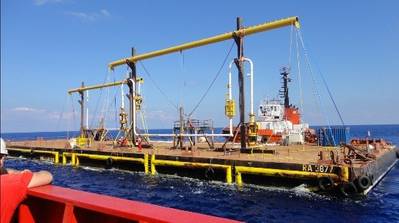Sonardyne Acoustic Positioning Saves Technip Time
Technip completes 21 subsea jumper metrology operations using Sonardyne International's Lodestar GyroCompatts & saves 8 days working time.
Using the latest Wideband Long BaseLine (LBL) acoustic positioning hardware by optimising its technique, Technip was able to complete each metrology operation in an average of 13 hours, with one such operation conducted in only 8 hours.
Subsea metrology requires accurate, precise and robust acoustic measurements so that a spool or jumper can be successfully fabricated and installed. For a low-risk, multi-functional and cost-effective solution to the project, Sonardyne recommended Lodestar GyroCompatts, integrating the features of the company’s most advance LBL transponder with a Lodestar Attitude and Heading Reference System (AHRS) in a single ROV-deployable subsea housing. This integration provides high update rate wireless attitude, heading, heave, surge, sway, pressure, sound velocity (SV) and acoustic positioning of any subsea object.
Edd Moller, Sonardyne’s Survey Support Group Manager explained, “One of the main challenges of acoustic metrology is to ensure that the measured wideband acoustic range can be translated accurately down from the transponder to the hub level. This is traditionally done using inclinometer Compatts which is then QC’d by rotating the Compatts in the hubs to determine misclosure in both the stab to hub mating and also inclinometer and alignment errors.
Thus the main purpose of this project was to simultaneously use a GyroCompatt in each hub with precision stabs and receptacles. Acoustic ranges could then be made whilst rotating the GyroCompatts and then using the attitude data recorded by the GyroCompatt, the projections of the hub position could be deduced. This meant Technip could compare the calculated Hub-to-Hub distances during the different rotations in order to justify removing the requirement for this alignment QC procedure altogether.”

















